 |
 |
|
monophonic
portable tube synth keyboard with
great electro
noises |
|
This portable tube instrument was basically the monophonic sister of
the Jörgensen Tuttivox.
But unlike the once very expensive Tuttivox, the Clavioline was
in 1950th to 1960th a halfway common instrument that was even manufactured
by multiple companies. The Clavioline could be mounted with screws and
2 metal brackets directly under the keyboard section of a piano (yes, the
heavy wooden thing with strings and felt hammers inside ;-) ),
because originally it was intended to be played in dance music bands by
the piano player to imitate acoustic string or wind instruments e.g. when
a band member was sick or the like.
But far beyond this, a Clavioline can do much more, because basically
it was a predecessor of the analogue synthesizer with lovely droning hardsync
tones those resemble multipulse squarewave and permit very sonorous and
buzzy electro bass noises those are great for tekkno. The sound is made
by a tube operated (sort of?) squarewave tone generator with a hardsynced
suboscillator (octave divider) that makes a sort of subharmonic mixture
(adds lower octave undertones). As well the main voice as the suboscillator
can be switched to different octaves. The resulting waveform is passed
through an analogue filter bank that is controlled by 10 combinable OBS
tab stop switches (i.e. no continuous controls). The attack phase of the
envelope can be switched between a soft (like flute) and a very percussive
popping one (intended for picked strings?), but at least my specimen has
no working envelope generator, i.e.. the rest of the envelope is a continuous
tone and its volume curve can be only controlled manually by a knee lever
(used much like a volume pedal). There is also a vibrato LFO with stepless
adjustable intensity and frequency, which makes great bizarre textures
when the octave is set so low that the tone frequency gets into the range
of the LFO.
On the type plate stands the manufacturer "Jörgensen - Electronic"
and the German address "Düsseldorf - Hüttenstr. 8". Jörgensen
made different Clavioline versions over time; my amplifier is model "V/C"
and the keyboard is model "M02". Both have the serial number "Y49" and
the note that it was licensed from Constant Martin, Rene Seybold and Harald
Bode. I don't know how rare my version is; at least I yet saw no other
with exactly the same case style on the internet.
main features:
-
36 midsize keys (very responsive, each key controls 2 wire contacts)
-
suitcase- style portable amplifier case with storage compartment for the
keyboard
-
20cm speaker (with tubby midrange resonance)
-
monophonic main voice
-
5 OBS waveform/ envelope tab stop switches {"< >", "A", "B", "P", "V"}
(combinable)
-
10 OBS filter control tab stop switches {"0".."9"} (combinable)
-
3 connected octave switches (4 settings, 6 octaves in total)
-
dynamic volume control by black bakelite knee lever
-
vibrato with depth & frequency control (left & right knob)
-
tuning & octave purity knob (holes at case bottom)
-
monophonic analogue tube sound generator with hardsynced suboscillator
(octave divider)
-
separate amplifier/ power supply box
-
7 pin organ connector with about 340V DC high voltage at bare jack contacts
without any touch protection (yikes!)
-
electronics mostly based on standard tubes (ECC81, ECC82, EF93, EZ81, 6V6)
but also contains one special tube ("STV 108/30, -OB2-").
-
reasonable maintainable case and hardware design
-
power consumption 65W (on type label stands 80W)
-
no sound output jacks
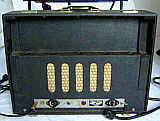 |
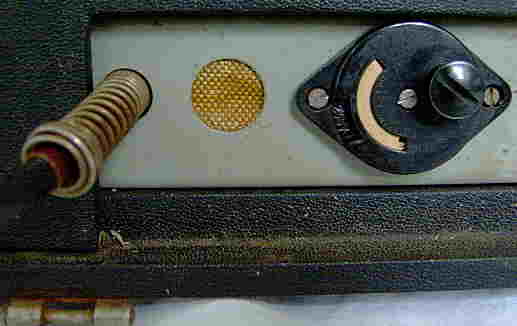 |

Jörgensen- Electronic
Type: V/C, Model Nr. Y49
110/220V 80W ... |
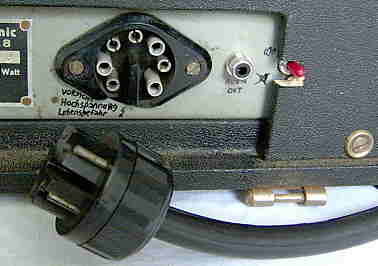 The
organ jack had bare contacts with about 340V high voltage. To the right
is my sound output jack with speaker mute switch. The
organ jack had bare contacts with about 340V high voltage. To the right
is my sound output jack with speaker mute switch. |
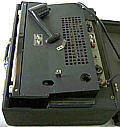 The
keyboard can be stored inside the amplifier case. The
keyboard can be stored inside the amplifier case. |
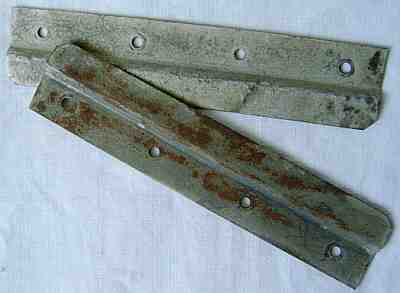 To play, it was originally mounted with its rear end under
a piano using these metal rails...
To play, it was originally mounted with its rear end under
a piano using these metal rails... |
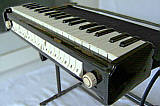
but it also fits well into my Tuttivox
stand. |
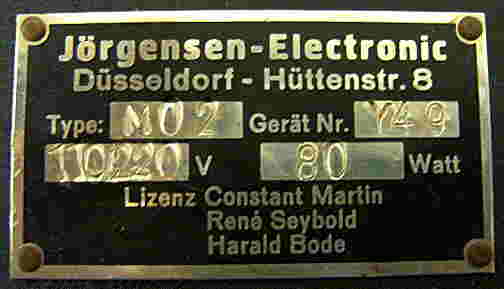
Jörgensen- Electronic
Type: M02, Model Nr. Y49 ... |
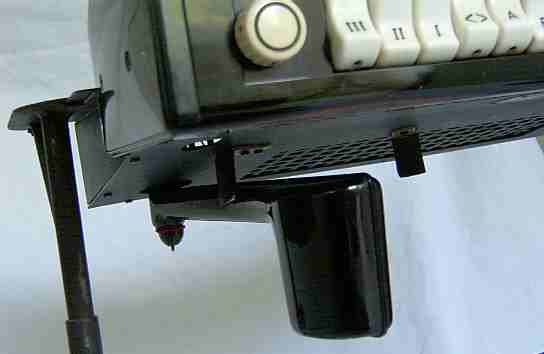 The only volume control was a detachable knee lever.
The only volume control was a detachable knee lever. |
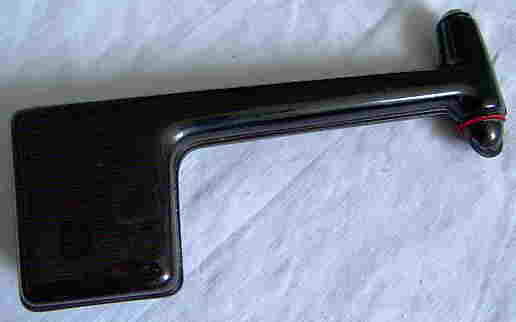
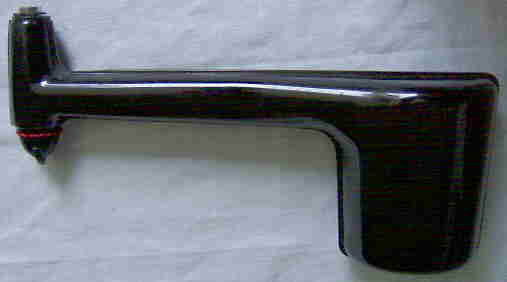 |
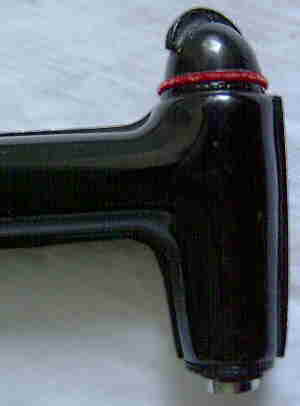 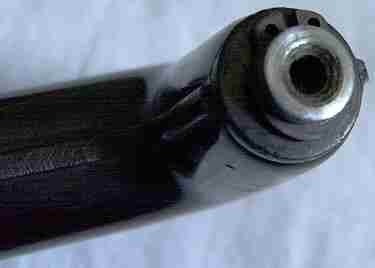
It is made of lightweight (but fragile) bakelite and
held by a clever screw fixture. The same lever type is also employed in
the Tuttivox. |
 18 combinable "tab stop" switches control the sound synthesis.
18 combinable "tab stop" switches control the sound synthesis. |
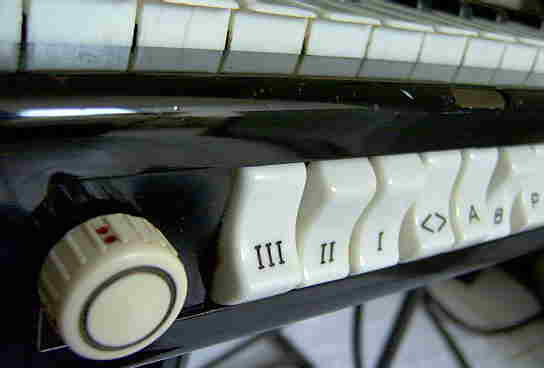
2 knobs set vibrato depth and speed. |
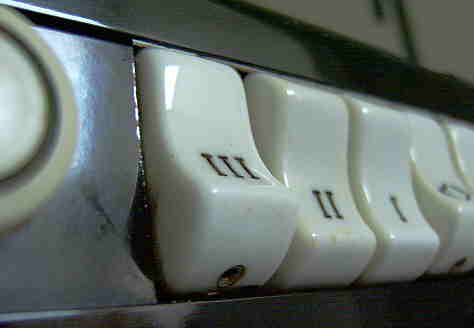
The vibrato knobs are mounted on an inserted metal panel.
Likely the case frame was designed more generic since other brands Clavioline
models had 22 switches and no knobs instead. |
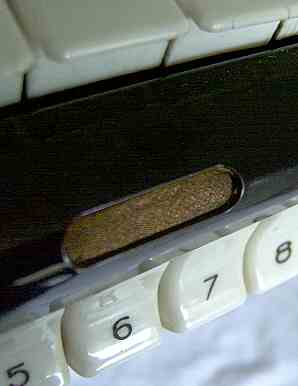 Above
the "tab stop" switches are 2 strange slots those are shut with glued fabric.
Other Clavioline models apparently had additional sliders here. Above
the "tab stop" switches are 2 strange slots those are shut with glued fabric.
Other Clavioline models apparently had additional sliders here. |
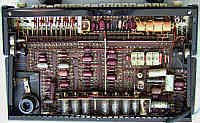 |
eastereggs:
-
the internal hardsync adjustment trimmer (potentiometer between the tubes)
can make great disharmonic distortions when misadjusted.
-
octave switches "I", "II", "III" set main and suboscillator to wrong pitches
when pushed only half.
-
the percussive "P" envelope can be temporary disabled by holding a key
halfway down.
-
holding a key while powering instrument on or off makes a howling siren
noise (but don't play too much with the power switch; it's bad for the
tube heaters).
modifications:
-
mains cable replaced with grounded one.
-
high voltage output jack touch- protected by shrink sleeve pieces.
-
amplifier case holes covered with nylon cloth as rudimentary HV voltage
touch protection.
-
sound output jack with speaker mute switch (and shunt resistor) added.
-
minimum and maximum volume control potentiometers added.
-
external hardsync control knob mounted on trimmer pot.
notes:
Although the Clavioline was invented already in 1947 (by Constant
Martin in France) and there are quite many references to it on the internet,
I found only one page about the Jörgensen version (on the site
Clavioline.com),
which shows even a different model with more tubes inside the amplifier
and claims that this one was built only in 1960th. Initially my instrument
had a lot of more or less rotten "explosive candy" capacitors (and a very
melted one in the amp), but fortunately these were easy to replace because
the hardware of the Jörgensen Clavioline is easy to maintain since
it hasn't the horrible 3 dimensional component mess like my Tuttivox,
but contains not more components than a good tube radio, and thus looks
like a reasonable, efficient hardware design for its age. (The Tuttivox
in opposite was an exceptionally crowded piece of electronics that had
cost certainly a moon price and appears to me more like meant as a fragile
but unaffordable electronics demonstration object than a robust instrument
to play on stage.)
On my Clavioline I also had to replace the smashed bakelite light bulb
fixture at the amp; because the chassis hole was too small, I initially
shattered the new plastic fixture when I used force during installation;
I used superglue to reassemble it and drilled the hole larger with household
scissors. For safety I replaced the 2 lead mains cable with a grounded
one. One of the leaf switch contacts under a key was cracked off; I replaced
it with a piece of sheet steel from a 3.5 inch diskette slider. Another
key had a bad solder joint and all switch contacts needed a clean with
sand paper. Unfortunately my Clavioline is missing a keyboard stand because
originally it was mounted with 2 smell sheet metal brackets at a piano,
but at least it fits well into my Tuttivox stand.
Warning: It is crucial always to unscrew and detach the knee
lever from the instrument bottom before taking the instrument out of its
stand (or brackets), since the lever is of brittle bakelite and may break
easily when the heavy instrument is accidentally dropped onto it.
 Thanks
to its combinable octave-, waveform- and filter switches, the
Jörgensen
Clavioline can make a lot of different timbres. The "P" switch adds
a loud and usually bassy popping percussive attack phase to the timbres,
which sounds between base drum and picked string depending on the actual
filter settings, but beside this there is not automatic decaying envelope
(or at least mine is broken). But in a 1960th movie I saw a stage pianist
with 2 Clavioline models (at least there were 2 amps) of those one apparently
even had an automatic mandolin ring effect (it rang quite fast and sounded
too regular for a manually trilled sound). The "P" envelope is not re-triggered
when keys are held down; only the pitch changes to the note of the currently
highest pressed key, which can be used as a sound effect. The "V" switch
is rather fake since it makes no own waveform or envelope but is only yet
another low pass filter switch. Here is a list what the switches
of my specimen do, although I am not sure if this is their intended behaviour:
Thanks
to its combinable octave-, waveform- and filter switches, the
Jörgensen
Clavioline can make a lot of different timbres. The "P" switch adds
a loud and usually bassy popping percussive attack phase to the timbres,
which sounds between base drum and picked string depending on the actual
filter settings, but beside this there is not automatic decaying envelope
(or at least mine is broken). But in a 1960th movie I saw a stage pianist
with 2 Clavioline models (at least there were 2 amps) of those one apparently
even had an automatic mandolin ring effect (it rang quite fast and sounded
too regular for a manually trilled sound). The "P" envelope is not re-triggered
when keys are held down; only the pitch changes to the note of the currently
highest pressed key, which can be used as a sound effect. The "V" switch
is rather fake since it makes no own waveform or envelope but is only yet
another low pass filter switch. Here is a list what the switches
of my specimen do, although I am not sure if this is their intended behaviour:
| tab stop switch |
function |
| octave switches: |
(Switches "I", "II", "III" are mechanically coupled and
can be theoretically only pushed in sequence.) |
| "I" |
1 octave lower |
| "I"+"II" |
2 octaves lower |
| "I"+"II"+"III" |
3 octaves lower |
| waveform/ envelope switches: |
(The suboscillator is muted unless "A" or "B" is pushed.) |
| "< >" |
sets main oscillator volume very low; only suboscillator
stay loud and turns a bit duller |
| "A" |
1 octave lower (a bit duller than octave switches, swaps
main and suboscillator?) |
| "B" |
sonorous multipulse bass, activates suboscillator 2 octaves
lower (with "A" main oscillator is 1 octave lower =>less harsh with more
mids) |
| "P" |
percussive popping attack phase & louder |
| "V" |
makes everything duller (simple low pass filter, should
have rather another number instead of the letter) |
| filter bank switches: |
|
| "1" (low pass) |
much duller and quieter |
| "2" (low pass) |
similar but less dull |
| "3" (low pass) |
same like "2" ("2"+"3" is even duller) |
| "4" (low pass) |
similar but less dull |
| "5" (treble resonance) |
brighter |
| "6" (treble resonance) |
same like "5" ("5"+"6" adds to combinations of "1".."4"
more mids, makes them more sonorous) |
| "7" (treble resonance) |
rises very high overtone (most noticeable with "9") |
| "8" (treble bypass) |
brighter (adds trebles independent from low pass filter
settings, "1" or "2" and not "0" make treble louder) |
| "9" (high pass) |
thinner (removes bass) |
| "0" (mode change) |
muffles "1".."2" (most noticeable with "7".."9"), does
nothing when "1".."2" unset |
With no switches set, the timbre resembles a bright flute at high notes
and a saxophone at lowers. On the site Clavioline.com
there is a list of sound "patches" with switch combinations to simulate
various acoustic instrument timbres.
Although the 10 filter "tab stops" are only on/ off switches and
no continuous (potentiometer) controls, they can be used in various creative
ways for realtime sound effects. E.g. by pressing a switch with a short
delay after playing a note, you can imitate a gritty pseudo- wahwah effect,
and you can also do a lot of rhythmic modulation effects by holding a key
down and manually switching the timbres. As you can imagine, the result
sounds very blocky since these are only individual switches and no smooth
filter sweeps or the like. But this gives the thing also a special sound
style, with that a lot of wicked electro tekkno stuff can be created, although
(like with a classic organ) the result depends much on the play skills
since this is nothing programmed but only played by hand. Don't fear -
the switches appear to be a durable minimalistic design; they contain simple
brass leaf contacts without clicking mechanical parts (similar like key
contacts), thus they are unlikely to break from repeated use despite their
caps are of fragile duroplastic. My Clavioline is badly shielded and makes
a lot of hum when placed next to a running (CRT based) TV set. The resulting
buzz also changes with the actual filter setting. Great is also that you
can set the octave so low that the bass range turns into a very buzzy purring
that resembles rather a motor bike or motor hum from historical car racing
videogames, and with vibrato it makes great bizarre textures when the octave
is set so low that the tone frequency gets into the same frequency range.
(Remember, there is a stepless vibrato amplitude and frequency control.)
But very noticeable is that the volume differs extremely among different
filter settings. Possibly this was the reason that there was no volume
control except the knee lever, which range this way reaches from (almost)
silence to maximum volume. Annoying is that the lever needs to be pressed
continuously to hear any sound, because it moves back into the silence
position by its return spring. Unfortunately there are no means of pitchbend
control (beside the awkward and fragile tuning knobs), although from everything
I read about the age and purpose of the Clavioline (namely to imitate
brass and string sounds) I had surely expected this thing to be more like
a trautonium than an ordinary keyboard instrument. By the monophonic tone
generator it would have been technically easy to integrate a ribbon controller,
to give the thing a rather theremin- like expressivity, not least because
the continuous volume control (knee lever) is already there, and its suboscillator
could make it sound almost like one half of Oskar Sala's (2 note polyphonic)
Mixtur Trautonium.
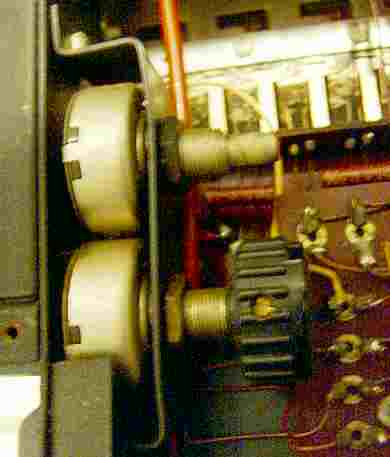
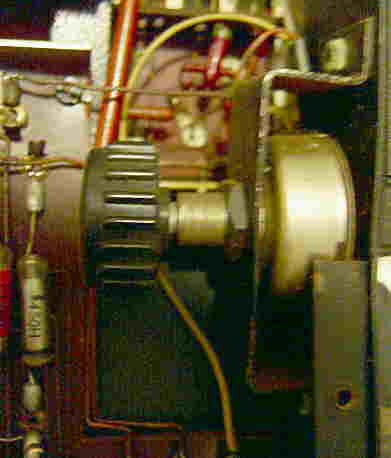 The
instrument can be tuned with a black bakelite knob hidden in a simple hole
to the left of the case bottom. A similar knob exists to the right to adjust
the octave linearity, i.e. it shifts the pitch of the high keyboard octave
notes against the low notes by few semitones. Generally this linearity
is not really perfect and makes the octaves a little disharmonic, especially
after switching the octave setting. But this can be also used as
a sound effect to make the sound "squint" in a lovely anarchic way. (These
are things you really can not do on average digital keyboards, and even
a mechanical Hammond organ stays always perfectly in tune within
itself and never leaves the chromatic scale.) Nasty is that these holes
contradict any modern CE consumer safety rules, because when you push your
fingers only some cm further in, you can easily damage cable solder joints
or (at the right knob) get a really unfriendly 78 volt jolt fired through
your bones from the keyboard envelope trigger voltage.
The
instrument can be tuned with a black bakelite knob hidden in a simple hole
to the left of the case bottom. A similar knob exists to the right to adjust
the octave linearity, i.e. it shifts the pitch of the high keyboard octave
notes against the low notes by few semitones. Generally this linearity
is not really perfect and makes the octaves a little disharmonic, especially
after switching the octave setting. But this can be also used as
a sound effect to make the sound "squint" in a lovely anarchic way. (These
are things you really can not do on average digital keyboards, and even
a mechanical Hammond organ stays always perfectly in tune within
itself and never leaves the chromatic scale.) Nasty is that these holes
contradict any modern CE consumer safety rules, because when you push your
fingers only some cm further in, you can easily damage cable solder joints
or (at the right knob) get a really unfriendly 78 volt jolt fired through
your bones from the keyboard envelope trigger voltage.
| This
is the classic loudspeaker cloth... |
|
...and
this a sample of the imitation leather material. |
|
The
case lid has a grey paper lining. |
repair & circuit bending details
Danger: Tube electronics works with
high voltage that can cause lethal electric shocks or fire. Thus don't
repair or modify these unless you know what you do.
amplifier cabinet:
The Jörgensen Clavioline instrument is powered by its external
tube amplifier. I read that with many such instruments the original amp
got lost, but likely also a new tube power supply could be build to resurrect
such incomplete specimen. There seem to be multiple amplifier versions
with different tube counts inside. My specimen has the model name "V/C"
and serial number "Y49"; its hardware is designed very strait forward like
from an educational book and contains only 3 tubes (1x "EZ81", 2x "6V6").
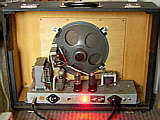 The amplifier contains only 3 tubes although there are holes
for 5. Also on the chassis front were 3 unused holes. All surplus holes
are closed with glued fabric.
The amplifier contains only 3 tubes although there are holes
for 5. Also on the chassis front were 3 unused holes. All surplus holes
are closed with glued fabric. |
The organ connector jack at the amp has the following pin assignment:
-
"+" 5.95V AC
-
NC
-
+237V
-
audio in
-
GND
-
-102V
-
GND
(counting right to left anticlockwise) |
 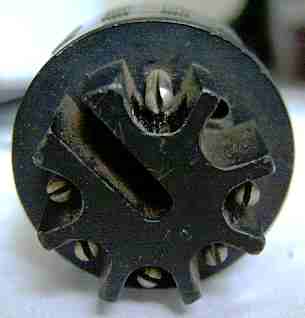 All
voltages were measured with transformer set to 240V mains voltage, organ
connected and "< >" switch off. The tube heater voltage of 5.95V (instead
of normal 6.3V) is a bit low, but setting the transformer into 220V mode
rises it to 6.53V, which is certainly worse for the tubes than a little
undervoltage. With "< >" on, the negative high voltage becomes -92V
and the positive high voltage becomes +245V. With organ disconnected, the
positive high voltage becomes +281V, and the negative voltage only -74V.
I shielded the high voltage pins with shrink sleeve pieces for touch protection.
Although the jack looks similar, the pin assignment is different from the
Jörgensen
Tuttivox. All
voltages were measured with transformer set to 240V mains voltage, organ
connected and "< >" switch off. The tube heater voltage of 5.95V (instead
of normal 6.3V) is a bit low, but setting the transformer into 220V mode
rises it to 6.53V, which is certainly worse for the tubes than a little
undervoltage. With "< >" on, the negative high voltage becomes -92V
and the positive high voltage becomes +245V. With organ disconnected, the
positive high voltage becomes +281V, and the negative voltage only -74V.
I shielded the high voltage pins with shrink sleeve pieces for touch protection.
Although the jack looks similar, the pin assignment is different from the
Jörgensen
Tuttivox. |
|
 In the amp chassis was a melted capacitor.
In the amp chassis was a melted capacitor. |
 This is the chassis with new caps, a new lamp and my sound output upgrade.
To the right you see the shunt resistor.
This is the chassis with new caps, a new lamp and my sound output upgrade.
To the right you see the shunt resistor. |
 For
high voltage touch protection I covered the amp vent holes with nylon mesh. For
high voltage touch protection I covered the amp vent holes with nylon mesh. |
My original mains cable had only 2 leads and thus no grounding. Due to
the metal case and chassis of the instrument it is strictly recommended
to replace it with a grounded mains cable to prevent the risk of electric
shocks in case of failures.
mains voltage selector & capacitor replacement
 To
select the mains voltage, unscrew and pull out the fuse holder at the mains
voltage selector. Then loosen the center screw, rotate the selector to
the new voltage setting and screw everything back into place. With my specimen
the fuse was corroded and thus got stuck and cracked apart. when I attempted
to remove it. When I finally managed to lever the sheet metal fragments
out of the holder, the fuse type was not readable anymore. Thus for 240V
I used a slow 630 mA fuse, which works well. (The instrument consumes only
65W (measured) although it claims 80W on the model plate.) Unlike claims
on the model plate, this instrument has not only a 110 and 220V AC setting,
but also one for 240V, which is the actual German mains voltage. When set
to 240V, the tube heater voltage of 5.95V (instead of normal 6.3V) is a
bit low, but setting the transformer into 220V mode rises it to 6.53V,
which is certainly worse for the tubes than a little undervoltage. To
select the mains voltage, unscrew and pull out the fuse holder at the mains
voltage selector. Then loosen the center screw, rotate the selector to
the new voltage setting and screw everything back into place. With my specimen
the fuse was corroded and thus got stuck and cracked apart. when I attempted
to remove it. When I finally managed to lever the sheet metal fragments
out of the holder, the fuse type was not readable anymore. Thus for 240V
I used a slow 630 mA fuse, which works well. (The instrument consumes only
65W (measured) although it claims 80W on the model plate.) Unlike claims
on the model plate, this instrument has not only a 110 and 220V AC setting,
but also one for 240V, which is the actual German mains voltage. When set
to 240V, the tube heater voltage of 5.95V (instead of normal 6.3V) is a
bit low, but setting the transformer into 220V mode rises it to 6.53V,
which is certainly worse for the tubes than a little undervoltage.
Danger: In the amplifier chassis the fuse holder is integral
part of the mains voltage selector, which routes the fuse protected voltage
directly to the individual mains transformer inputs. Thus to take effect
at any voltage settings, the mains filter capacitor was placed in the unfused
part directly across the mains lines behind the power switch. This is a
dangerous design flaw which may cause the amplifier catch fire, since the
employed Niwatrop capacitors are of very questionable quality and
tend to melt and burn out sooner or later. It therefore would be only a
matter of time when this timebomb will blow up, and thus it is strictly
necessary to replace this "explosive candy" cap with a modern foil
capacitor that can bear 240V mains voltage.
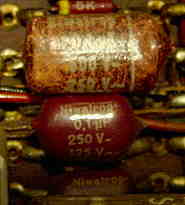 To
avoid further trouble, replace all Niwatrop capacitors in the amplifier,
and it is a good idea also to replace inside the instrument at least any
Niwatrop
caps those have cracks or are not perfectly smooth, shiny and dark red
anymore. To
avoid further trouble, replace all Niwatrop capacitors in the amplifier,
and it is a good idea also to replace inside the instrument at least any
Niwatrop
caps those have cracks or are not perfectly smooth, shiny and dark red
anymore.
|
add a sound output jack
 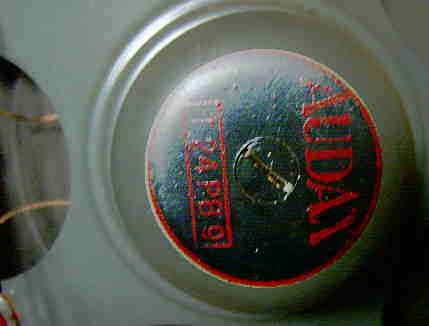 Strange
is that (unlike my Tuttivox)
this Clavioline had no sound output jacks; likely because it was a much
cheaper instrument and not designed as a really professional stage instrument,
but it may also be that at its time there were anyway no real studio mixers
yet, and thus it was standard to record everything through a microphone
from the internal speaker. The loudspeaker is an Audax model with
chassis- mounted output transformer and the very unusual speaker impedance
of only 2.5 Ohm. (Normally old tube hardware tends to have rather high
impedances like 16 or 32 Ohm but not anything below 5 Ohm.) I installed
into given amplifier chassis holes a cinch sound output jack and a speaker
mute switch, which loads the output transformer with a 3 Ohm power resistor
when muted. (Tube amps need a shunt resistor with speaker disconnected
to prevent high voltage damage.) Strange
is that (unlike my Tuttivox)
this Clavioline had no sound output jacks; likely because it was a much
cheaper instrument and not designed as a really professional stage instrument,
but it may also be that at its time there were anyway no real studio mixers
yet, and thus it was standard to record everything through a microphone
from the internal speaker. The loudspeaker is an Audax model with
chassis- mounted output transformer and the very unusual speaker impedance
of only 2.5 Ohm. (Normally old tube hardware tends to have rather high
impedances like 16 or 32 Ohm but not anything below 5 Ohm.) I installed
into given amplifier chassis holes a cinch sound output jack and a speaker
mute switch, which loads the output transformer with a 3 Ohm power resistor
when muted. (Tube amps need a shunt resistor with speaker disconnected
to prevent high voltage damage.) |
cabinet metal letter restoration
A common problem with the Jörgensen Clavioline is that the
metal letters on front of the amplifier case cracked off and got lost over
time. As seen on Clavioline.com, Jörgensen
made these brand signs in multiple different styles, although the specimens
I saw there were in even worse condition than mine.
The embossed brand signs on the amplifier case were apparently punched
out of sheet copper and badly tin or zinc plated (some spots left bare).
The "i" letter in my word "Clavioline" was cracked off, thus I carefully
embossed a new one of thin sheet aluminium, using the given "i" as a mould.
Also the "n" and an underline piece in "Jörgensen" was gone, but its
shape was still visible by glue remains underneath, thus I could imitate
these missing parts with the same method and hotglued all of them into
place. The result doesn't look perfect, but at least the writing is completed.
inside the main case:
 The tube instrument is an efficient hardware design...
The tube instrument is an efficient hardware design... |
There were multiple versions of the Jörgensen Clavioline
main device with different tube counts inside. My specimen has the model
name "M02" and serial number "Y49". Special in this model is the gas discharge
tube "STV 108/30, -OB2-", which may be a voltage regulator. The other tubes
(1x "ECC81", 5x "ECC82", 1x "EF93") are standard types. Mine seems to contain
more components than other brand versions shown on Clavioline.com,
despite it is not even a "Concert" model.
 ...but contained plenty of more or less rotten Niwatrop
"explosive candy" capacitors, thus I replaced most of them.
...but contained plenty of more or less rotten Niwatrop
"explosive candy" capacitors, thus I replaced most of them. |

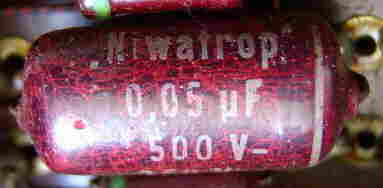 |
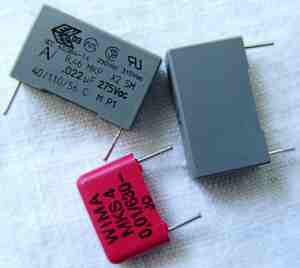 The new caps may look less pretty, but increase reliability
a lot.
The new caps may look less pretty, but increase reliability
a lot. |
volume control
 The
knee lever pulls the sound output voltage through a capacitor against GND(?)
to reduce the volume. When not pushed, the resistance is near 0 Ohm and
thus the sound is very quiet. When the lever is pushed right, the wiper
of the custom made potentiometer slides over its carbon trace to increase
the resistance (up to about 130 kOhm with logarithmic behaviour) and thus
increases the volume. The carbon trace of my specimen was worn out, which
made the lever fail and thus stayed at maximum volume. To fix this, the
wiper finger can be shifted after loosening a screw. Also the contact screw
on the trace was loose and had to be fastened (use no excessive force here
- it may crush the trace board easily). The
knee lever pulls the sound output voltage through a capacitor against GND(?)
to reduce the volume. When not pushed, the resistance is near 0 Ohm and
thus the sound is very quiet. When the lever is pushed right, the wiper
of the custom made potentiometer slides over its carbon trace to increase
the resistance (up to about 130 kOhm with logarithmic behaviour) and thus
increases the volume. The carbon trace of my specimen was worn out, which
made the lever fail and thus stayed at maximum volume. To fix this, the
wiper finger can be shifted after loosening a screw. Also the contact screw
on the trace was loose and had to be fastened (use no excessive force here
- it may crush the trace board easily).
 Normally
the instrument can not be played without always pushing the knee lever,
because the spring loaded lever otherwise returns to zero volume position.
To fix this, add a logarithmic 100 kOhm potentiometer in series to the
lever pot to make the minimum volume (with unpushed lever) adjustable.
To reduce the maximum volume (with lever pushed fully right), add another
potentiometer parallel to [lever pot in series to min. volume pot]. For
this I used an old 50 kLog potentiometer with carbon trace cut (by screwdriver)
at its right end to disable its volume limiting effect when turned fully
right. I mounted mine with a piece of sheet plastic and hotglue, although
there are certainly more elegant solutions. Normally
the instrument can not be played without always pushing the knee lever,
because the spring loaded lever otherwise returns to zero volume position.
To fix this, add a logarithmic 100 kOhm potentiometer in series to the
lever pot to make the minimum volume (with unpushed lever) adjustable.
To reduce the maximum volume (with lever pushed fully right), add another
potentiometer parallel to [lever pot in series to min. volume pot]. For
this I used an old 50 kLog potentiometer with carbon trace cut (by screwdriver)
at its right end to disable its volume limiting effect when turned fully
right. I mounted mine with a piece of sheet plastic and hotglue, although
there are certainly more elegant solutions.
|
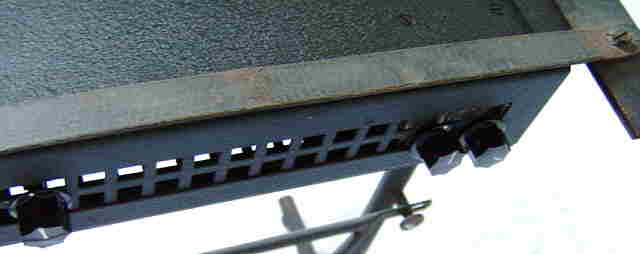 |
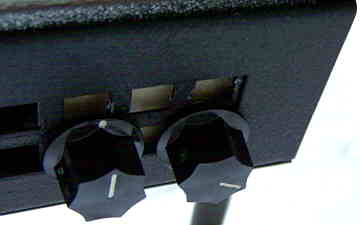 |
These are the added hardsync and volume controls; I equipped
them with classic bakelite knobs.
tuning & octave linearity pots
  There
are 2 hidden knobs in case bottom holes; the left one adjusts tuning, while
the right one adjusts octave linearity. It is a good idea to glue some
sheet plastic behind them to prevent cable damage and electric shocks. There
are 2 hidden knobs in case bottom holes; the left one adjusts tuning, while
the right one adjusts octave linearity. It is a good idea to glue some
sheet plastic behind them to prevent cable damage and electric shocks.
Initially my tuning and octave linearity potentiometers were stuck and
didn't turn well because their oil was hardened. A drop of isopropanol
and new machine oil at the capstan gap helps a lot here. (Do not attempt
to turn with raw force; the brittle bakelite knobs may break easily.) Dismantling
the pot didn't help, because the capstan is bolted and can not be pulled
out for cleaning even when the back of the potentiometer is opened. The
knobless "trimmer" pot next to the tuning pot seems to be another octave
linearity control. |
hardsync control knob
| Between the tubes in the back of the instrument is a trimmer potentiometer
(quite big, like a normal one) to adjust the operating point of the hardsynced
suboscillator (octave divider). The suboscillator is only active during
certain waveforms; when normally adjusted, all notes on the keyboard will
have the same timbre. But this knob rocks way too much to keep it there,
because when "misadjusted", the suboscillator will make a foldback to a
lower (wrong) octave on higher note keys (was the case when I bought the
instrument), and in other settings the timbre varies cyclically every n-th
note (similar like a ring modulator). The resulting warm roaring overtone
structures resemble a distorted heavy metal guitar or overblown saxophone
or like stepping through the individual buzz timbres on the Atari
POKEY sound chip (like the ascending motor hum in Atari VCS2600
car racing games), and some settings and note combinations even remind
to a howling wolf. To make it available, I simply cut a small hole into
the back grill and prolonged the potentiometer capstan with a plastic stick
that I connected it in a semi- flexible way by pushing a piece of PVC mains
cable insulation over both ends. By the (clutch- like) flexibility, the
knob can be safely rotated over the limits of the potentiometer to bring
the mark on the knob (mine is simply hotglued to the stick) into correct
position to indicate the neutral position when facing up.
With unknown internal trimmers it is always important to verify that
they won't overload other components when turned too far, but I have checked
with a power meter in the mains socket that the power consumption of the
instrument stays independent from its actual trimmer setting (and also
the tubes don't glow abnormally), thus it is unlikely that the new control
knob will damage the oscillator tubes. |
key contact maintenance
 The key contacts were oxidized, had bad solder joints and one was cracked
off...
The key contacts were oxidized, had bad solder joints and one was cracked
off... |
 but after removing both bakelite sides and side screws, the keyboard can
be flipped up for maintenance.
but after removing both bakelite sides and side screws, the keyboard can
be flipped up for maintenance. |
 |
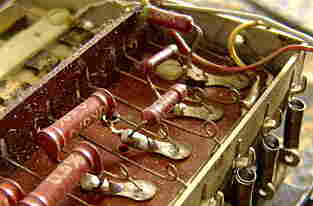
The key levers are held up by a row of springs. |
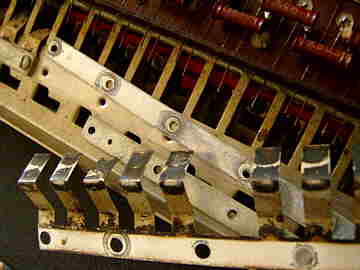 One
of these silver plated leaf switch contacts was cracked off and missing. One
of these silver plated leaf switch contacts was cracked off and missing. |
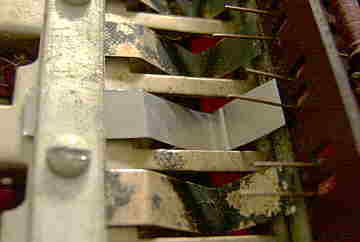 I
replaced it with a sheet steel piece made from a 3.5'' diskette slider;
the key works perfectly now. I
replaced it with a sheet steel piece made from a 3.5'' diskette slider;
the key works perfectly now. |
With keyboard flipped up, the key contacts can be easily cleaned with fine
sand paper. Important is to straiten bent contact wires to make the keys
respond equally. Also the tab stop switches may need cleaning and adjustment,
but they can be easily reached with case bottom removed.
control voltage inputs - adding a ribbon controller?
| The keyboard has 2 contacts per key, made from each 2 wires touched
by a grounded leaf spring contact. The first contact controls the note
pitch; these contacts of all keys are wired in series with resistors in
between, forming a voltage divider chain with one resistor per key. The
VCO input line has -20V with no key pressed, and is pulled up to 0V at
the rightmost key. The control voltage does not change by the octave switches.
The VCO input measures against GND 416 kOhm with no key pressed, 260 kOhm
with the highest note key pressed and 0 Ohm with the lowest note key pressed.
The 2nd contact triggers the envelope and these are wired parallel at all
keys. With no keys pressed, there are about 78V on this line. With keys
pressed, the voltage reduces to 21.7V with "P" switched off, and to 0.6V
with "P" switched on.
Although by the high voltages I would not recommend to add the ordinary
touch sensor contacts known from circuit bending, it would be very worth
the effort to upgrade this thing with a genuine ribbon controller, like
known from a Trautonium or Ondes Martenot. To get the hands
free to play with the switches, theoretically also a MIDI converter could
be connected to the VCO control lines, but I doubt that the voltage per
octave ratio of the control voltage input is anything standardized. Otherwise
a homemade opto- mechanical loop sequencer wheel in the style of a 1950th
Circle
Machine would anyway fit better to the appeal of this ancient tube
synthesizer, and with optional crank and flywheel it would be much more
fun also. |
|
The Clavioline was manufactures by multiple companies; beside
Jörgensen
there were also versions made by Selmer, Gibson and Bode,
those had different case and hardware designs (e.g. vibrato switches
instead of knobs). Selmer and Gibson variants were also released
as "concert" models with 4 additional waveform tab stops (e.g. for "clarinet").
On the Selmer model (seen on eBay) these 4 black switches
were labelled {"SUB I p", "SUB II p", "SUB I f", "SUB II f"}. The "p" and
"f" may be "piano" and "forte" (quiet and loud) while "SUB I" and "SUB
2" certainly refer to the suboscillator. Either this instrument had a second
suboscillator or only 2 suboscillator (octave?) settings where each setting
could play quiet or loud. Also one of the normal waveform switches was
labelled "F". For vibrato it had 3 black "vibrato" and 1 "amplitude" switch;
my Jörgensen model controls both stepless by potentiometers. Selmer
released in 1963 also a concert model with built-in spring reverb. In Italy
a concert model was released with the name "Ondiola". Similar instruments
like the Clavioline (but with partly different timbres) were the Ondioline,
(in Holland "Orcheline"), the Lipp Pianoline, the Jennings
Univox and the Hammond Solovox. The latter was likely the world
first electronic mini keyboard (invented in 1940), because although its
wooden main cabinet was quite large, the keyboard itself had almost as
small keys as My Music Center.
More info about these instruments can be found on the site Clavioline.com.
A remotely similar like the Clavioline sounding (but modern and much cheaper)
analogue instrument is also my modified toy tablehooter Golden
Camel 7A.
| removal
of these screws voids warranty... |
|
|
 |

|
|
| |
back
|
|


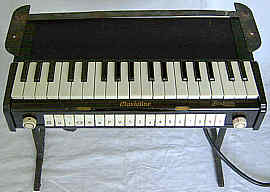
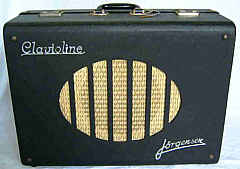
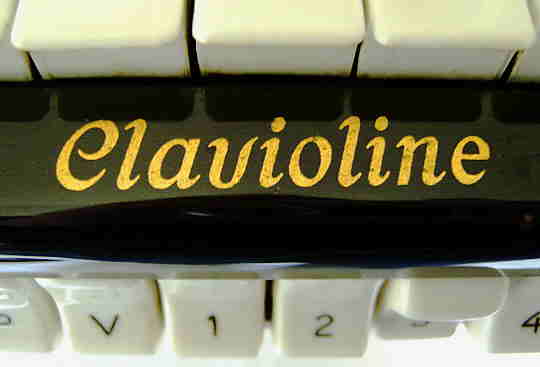



 The
organ jack had bare contacts with about 340V high voltage. To the right
is my sound output jack with speaker mute switch.
The
organ jack had bare contacts with about 340V high voltage. To the right
is my sound output jack with speaker mute switch. The
keyboard can be stored inside the amplifier case.
The
keyboard can be stored inside the amplifier case.


 The only volume control was a detachable knee lever.
The only volume control was a detachable knee lever.



 Above
the "tab stop" switches are 2 strange slots those are shut with glued fabric.
Other Clavioline models apparently had additional sliders here.
Above
the "tab stop" switches are 2 strange slots those are shut with glued fabric.
Other Clavioline models apparently had additional sliders here.
 Thanks
to its combinable octave-, waveform- and filter switches, the
Jörgensen
Clavioline can make a lot of different timbres. The "P" switch adds
a loud and usually bassy popping percussive attack phase to the timbres,
which sounds between base drum and picked string depending on the actual
filter settings, but beside this there is not automatic decaying envelope
(or at least mine is broken). But in a 1960th movie I saw a stage pianist
with 2 Clavioline models (at least there were 2 amps) of those one apparently
even had an automatic mandolin ring effect (it rang quite fast and sounded
too regular for a manually trilled sound). The "P" envelope is not re-triggered
when keys are held down; only the pitch changes to the note of the currently
highest pressed key, which can be used as a sound effect. The "V" switch
is rather fake since it makes no own waveform or envelope but is only yet
another low pass filter switch. Here is a list what the switches
of my specimen do, although I am not sure if this is their intended behaviour:
Thanks
to its combinable octave-, waveform- and filter switches, the
Jörgensen
Clavioline can make a lot of different timbres. The "P" switch adds
a loud and usually bassy popping percussive attack phase to the timbres,
which sounds between base drum and picked string depending on the actual
filter settings, but beside this there is not automatic decaying envelope
(or at least mine is broken). But in a 1960th movie I saw a stage pianist
with 2 Clavioline models (at least there were 2 amps) of those one apparently
even had an automatic mandolin ring effect (it rang quite fast and sounded
too regular for a manually trilled sound). The "P" envelope is not re-triggered
when keys are held down; only the pitch changes to the note of the currently
highest pressed key, which can be used as a sound effect. The "V" switch
is rather fake since it makes no own waveform or envelope but is only yet
another low pass filter switch. Here is a list what the switches
of my specimen do, although I am not sure if this is their intended behaviour:

 The
instrument can be tuned with a black bakelite knob hidden in a simple hole
to the left of the case bottom. A similar knob exists to the right to adjust
the octave linearity, i.e. it shifts the pitch of the high keyboard octave
notes against the low notes by few semitones. Generally this linearity
is not really perfect and makes the octaves a little disharmonic, especially
after switching the octave setting. But this can be also used as
a sound effect to make the sound "squint" in a lovely anarchic way. (These
are things you really can not do on average digital keyboards, and even
a mechanical Hammond organ stays always perfectly in tune within
itself and never leaves the chromatic scale.) Nasty is that these holes
contradict any modern CE consumer safety rules, because when you push your
fingers only some cm further in, you can easily damage cable solder joints
or (at the right knob) get a really unfriendly 78 volt jolt fired through
your bones from the keyboard envelope trigger voltage.
The
instrument can be tuned with a black bakelite knob hidden in a simple hole
to the left of the case bottom. A similar knob exists to the right to adjust
the octave linearity, i.e. it shifts the pitch of the high keyboard octave
notes against the low notes by few semitones. Generally this linearity
is not really perfect and makes the octaves a little disharmonic, especially
after switching the octave setting. But this can be also used as
a sound effect to make the sound "squint" in a lovely anarchic way. (These
are things you really can not do on average digital keyboards, and even
a mechanical Hammond organ stays always perfectly in tune within
itself and never leaves the chromatic scale.) Nasty is that these holes
contradict any modern CE consumer safety rules, because when you push your
fingers only some cm further in, you can easily damage cable solder joints
or (at the right knob) get a really unfriendly 78 volt jolt fired through
your bones from the keyboard envelope trigger voltage.
